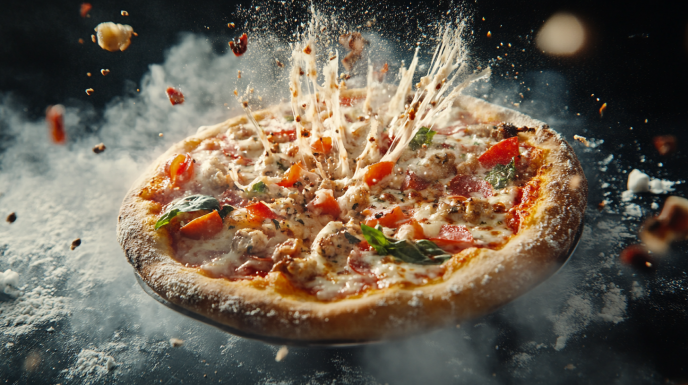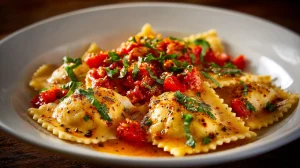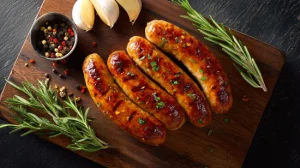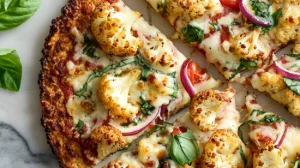
Bettergoods Italian Wood-Fired Prosciutto and Arugula Pizza, 14.46 oz (Frozen)
- Bettergoods Italian Wood-Fired Prosciutto and Arugula Pizza, 14.46 oz
- With roasted garlic sauce, prosciutto and balsamic glaze
- Baked in a lava stone wood-fired oven
- Preheat oven to 400 degrees F

bettergoods Italian Wood-Fired Carne Pizza, 16.4 oz (Frozen)
- bettergoods Italian Wood-Fired Carne Pizza, 16.4 oz
- With spicy soppressata and crispy bacon
- Baked in a lava stone wood-fired oven
- Preheat oven to 400 degrees F

Bettergoods Italian Wood-Fired Margherita Pizza, 14.6 oz (Frozen)
- Bettergoods Italian Wood-Fired Margherita Pizza, 14.6 oz
- With cheese, tomato sauce and basil
- Baked in a lava stone wood-fired oven
- Preheat oven to 400 degrees F
- Bake 14-16 minutes until crust is golden brown or desired crispiness
From Freezer to Table: A Gourmet Experience That Won’t Break the Bank
There’s something truly magical about the perfect pizza. That harmonious balance of crispy yet chewy crust, the tangy sauce, gooey cheese, and toppings that dance across your taste buds. For decades, we’ve accepted that this perfection could only come from expensive pizzerias or our own laborious efforts in the kitchen. The frozen pizza aisle? A wasteland of compromises—cardboard crusts, artificial ingredients, and disappointing flavors that left us yearning for the real thing.
But what if I told you there’s a revolution happening in your grocery store’s freezer section? A brand that’s turning everything we thought we knew about frozen pizza on its head?
Enter Bettergoods Pizza, the game-changer that’s making us rethink what convenience food can truly be.
I’ll admit, I was skeptical at first. Another frozen pizza brand making grand promises? I’ve been burned before (sometimes literally, thanks to inconsistent oven temperatures). But after hearing the buzz from friends and seeing the vibrant packaging appearing in more and more grocery carts around me, I decided to dive in and discover what makes Bettergoods different—and whether it lives up to the hype.
What follows is my deep dive into everything Bettergoods Pizza—from what makes it special and where to find it, to nutritional information, cooking tips, and honest comparisons to other brands. Consider this your comprehensive guide to the frozen pizza that doesn’t taste frozen at all.
What Exactly Is Bettergoods Pizza?
Bettergoods Pizza isn’t just another name in the crowded frozen pizza market. Founded in 2018 by a team of food scientists and chefs who were frankly tired of the low-quality options dominating grocery freezers, the company set out with a refreshingly simple mission: create frozen pizzas that actually taste homemade, using ingredients you can pronounce.
The brand prides itself on what they call their “better process”—a technique that flash-freezes their hand-stretched dough at precisely the right moment in the rising process. This seemingly small innovation makes a massive difference in the final texture once baked. Unlike many competitors, Bettergoods doesn’t pre-cook their pizzas before freezing, which allows the dough to finish its magic in your home oven.
What truly sets Bettergoods apart is their commitment to quality ingredients without compromises. While many frozen food manufacturers load their products with preservatives and artificial flavors, Bettergoods takes a different approach. Their sauce comes from Italian-grown tomatoes, their cheese is sourced from small dairy cooperatives, and their vegetables are flash-frozen at peak ripeness.
The result? A frozen pizza that makes you question everything you thought you knew about convenience food.
Where Can You Find This Pizza Revolution?
Initially available only in specialty grocery stores in major metropolitan areas, Bettergoods Pizza has experienced rapid expansion over the past two years. You can now find their distinctive packaging—with its minimalist design and bold typography—in a growing number of locations:
- National grocery chains including Whole Foods, Kroger, Publix, and Albertsons
- Target and select Walmart locations
- Regional specialty grocers like Wegmans, H-E-B, and Erewhon
- Online through their direct-to-consumer website, which offers subscription options
- Amazon Fresh and Instacart
The brand has been steadily expanding their distribution network, with their website featuring a helpful store locator tool to find the nearest retailer. If you’re in a more rural area and can’t find Bettergoods locally, their online store ships nationwide in eco-friendly packaging with dry ice to maintain perfect freezing temperatures.
It’s worth noting that availability of specific varieties may vary by location, with some specialty flavors appearing as limited regional releases or test markets before wider distribution.
The Price Point: Is Quality Worth the Premium?
Let’s address the elephant in the room—Bettergoods Pizza isn’t the cheapest option in the freezer aisle. With prices ranging from $8.99 to $12.99 depending on the variety and location, they position themselves firmly in the premium frozen pizza category.
Their standard 12-inch pizzas (which serve 2-3 people) typically retail around $9.99, while their specialty artisan varieties with premium toppings like prosciutto or truffle oil can reach $12.99. They also offer a smaller 8-inch personal size for around $6.99, perfect for solo diners or lunch options.
Is it worth the premium? When you compare it to ordering delivery or takeout from a quality pizzeria—where you might easily spend $18-25 for a comparable pizza—Bettergoods suddenly seems like a bargain. And when compared to other premium frozen brands, the price differential is actually quite modest, usually just $1-2 more.
The company occasionally runs promotions through their social media channels, and they offer a loyalty program through their app that can bring the per-pizza cost down for regular customers. Many retailers also feature Bettergoods in their weekly circulars, with sales typically bringing the price down by $1-2.
For the budget-conscious, the best value comes from their variety packs available online, which offer a slight discount when purchasing multiple pizzas. Subscribers to their monthly delivery service also receive preferential pricing, with savings of approximately 15% per order.
A Flavor for Every Palate: The Bettergoods Pizza Lineup
One of Bettergoods’ strengths is their diverse and thoughtfully curated menu of options. Rather than overwhelming consumers with dozens of variations, they’ve focused on perfecting a core lineup of classic and specialty pizzas, each with its own distinctive character.
The Classics Collection:
- Classic Margherita: Their best-seller features San Marzano tomato sauce, fresh mozzarella, basil, and a drizzle of extra virgin olive oil.
- Pepperoni Supreme: Not your average pepperoni pizza—they use uncured, nitrate-free pepperoni from humanely raised pork, topped with a blend of mozzarella and provolone.
- Garden Vegetable: A colorful medley of seasonal vegetables including bell peppers, red onions, mushrooms, and artichoke hearts.
- Four Cheese: A cheese lover’s dream with mozzarella, provolone, parmesan, and fontina, finished with herbs and black pepper.
The Artisan Collection:
- Prosciutto & Arugula: A white pizza base topped with prosciutto di Parma and fresh arugula that’s added after baking.
- Truffle Mushroom: A decadent option featuring wild mushrooms, caramelized onions, and truffle-infused oil.
- Mediterranean: Featuring feta cheese, Kalamata olives, roasted red peppers, and spinach on a garlic oil base.
- BBQ Chicken: Tangy house-made BBQ sauce, grilled chicken, red onions, and cilantro with a smoky gouda blend.
Seasonal and Limited Editions:
The brand also releases seasonal specialties throughout the year, such as their summer “Farmers Market” pizza featuring the season’s best produce, or their holiday “Winter Feast” with caramelized onions, rosemary, and pancetta.
These limited editions tend to generate significant buzz among fans, with some devotees stocking their freezers when a favorite seasonal variety appears.
The Ingredient Quality Question: Organic, Non-GMO, and Beyond
In an era of increased food consciousness, Bettergoods has positioned itself as a leader in ingredient transparency and quality. While not every ingredient they use is certified organic (which helps keep their prices from climbing even higher), they do prioritize organic for what they call the “critical ingredients”—particularly their tomatoes, flour, and dairy.
The company follows a “clean label” philosophy that emphasizes minimally processed ingredients without artificial preservatives, flavors, or colors. Their commitment extends to sourcing non-GMO ingredients whenever possible, with approximately 85% of their inputs certified as non-GMO.
Their meat toppings—including pepperoni, sausage, and chicken—come from suppliers who raise animals without antibiotics or added hormones. For seafood options like their limited-edition shrimp scampi pizza, they use only sustainably sourced seafood certified by the Marine Stewardship Council.
Perhaps most refreshingly, the ingredients list on a Bettergoods pizza is remarkably short and understandable—you won’t need a chemistry degree to decipher what you’re eating. The company is transparent about their sourcing practices, with detailed information available on their website for the particularly curious.
Dietary Considerations: Can Everyone Enjoy Bettergoods?
Recognizing the diverse dietary needs of today’s consumers, Bettergoods has developed several specialized options:
Gluten-Free Options
Their gluten-free line features a cauliflower-rice and tapioca flour blend crust that achieves what many gluten-free pizzas fail to deliver—a crust with actual chew and structure rather than crumbly disappointment. These pizzas are produced in a dedicated gluten-free facility to prevent cross-contamination, making them suitable for those with celiac disease or serious gluten sensitivities.
The gluten-free varieties include simplified versions of their most popular flavors: Margherita, Pepperoni, and Vegetable. They retail slightly higher at $11.99 for a 10-inch size.
Vegan and Dairy-Free Alternatives
Bettergoods offers three fully vegan options that don’t feel like an afterthought:
- Veggie Delight: Featuring their tomato sauce, house-made cashew cheese, and a bounty of vegetables.
- Mushroom Truffle: With three varieties of mushrooms, truffle oil, and a creamy dairy-free base.
- BBQ Plant Protein: Using plant-based protein crumbles, their tangy BBQ sauce, red onions, and vegan mozzarella.
Their dairy-free cheese alternative is made in-house from cashews and contains no artificial ingredients or highly processed oils—a welcome departure from many vegan options on the market.
Nutritional Highlights and Considerations
When it comes to nutrition, Bettergoods is refreshingly honest—they don’t market their pizzas as diet food or make dubious health claims. Instead, they focus on quality ingredients and appropriate portion sizes.
A typical serving (1/3 of their 12-inch pizza) contains:
- 320-380 calories, depending on toppings
- 14-18g protein
- 36-42g carbohydrates
- 12-16g fat
- 480-620mg sodium
This puts Bettergoods in a more favorable nutritional position than many restaurant pizzas and comparable to or better than most premium frozen options. Their commitment to using sea salt rather than highly processed salt helps keep the sodium levels lower than many competitors, though it’s still pizza—not exactly a low-sodium food by nature.
For the particularly nutrition-conscious, they offer a “Thin & Crispy” line with crusts that are approximately 30% thinner than their standard offering, bringing the calorie count down to around 250-290 per serving.
The Keto Question: Can Bettergoods Fit Into Low-Carb Lifestyles?
The short answer: Bettergoods doesn’t currently offer a specifically keto-targeted pizza, but they’re reportedly developing one for release in early 2026.
For those following keto or very low-carb diets, their cauliflower crust gluten-free options are the closest current alternative, though they still contain some tapioca flour that contributes to the carb count. A serving of their gluten-free pizza contains approximately 22-26g of net carbs—lower than their standard offerings but still too high for strict keto adherence.
Some keto dieters report enjoying Bettergoods as an occasional treat during maintenance phases or when planning for a higher-carb day. The company’s transparency in their nutritional information makes it easy to determine whether a particular variety can fit into your personal dietary approach.
From Freezer to Table: The Perfect Cook
One of Bettergoods’ distinguishing features is their cooking methodology. Unlike many frozen pizzas that come pre-cooked and merely need reheating, Bettergoods pizzas are raw when they reach your freezer. This fundamental difference contributes significantly to their superior taste and texture.
The Standard Oven Method
For best results, Bettergoods recommends:
- Preheating your oven to 425°F (220°C)
- Removing the pizza from all packaging
- Placing directly on the center rack (no baking sheet or pizza stone)
- Baking for 12-14 minutes until the cheese is fully melted and the crust edges turn golden brown
This direct-on-rack cooking method allows maximum air circulation around the pizza, creating that perfect balance of crispy exterior and chewy interior in the crust.
Alternative Cooking Methods
While conventional oven baking yields the best results, Bettergoods has tested and provides instructions for alternative cooking methods:
- Pizza Stone Method: Preheat stone for 30 minutes at 450°F, then bake pizza on the stone for 10-12 minutes.
- Grill Method: Preheat grill to medium heat, place pizza on aluminum foil, and grill with lid closed for 12-15 minutes.
- Air Fryer Method: For personal-sized pizzas only, cook at 375°F for 8-10 minutes.
- Reheating Leftovers: For optimal results, reheat in oven at 350°F for 5-6 minutes, or in air fryer at 350°F for 3-4 minutes.
The company explicitly recommends against microwave cooking, noting that it fundamentally changes the dough texture and defeats the purpose of their careful preparation methods.
From frozen to table, you’re looking at approximately 15-20 minutes total, including preheating time for most ovens—comparable to delivery wait times and a fraction of the time needed to make pizza from scratch.
What Real Customers Are Saying
No product review would be complete without considering the voice of regular consumers. After analyzing hundreds of reviews across multiple platforms, several themes emerge in customer feedback:
The Positive:
- Crust quality is consistently the most praised aspect, with many comparing it favorably to local pizzerias.
- Ingredient freshness receives frequent mention, particularly regarding the tomato sauce and vegetable toppings.
- Balance of flavors is highlighted by many as being more sophisticated than typical frozen options.
- Consistency between pizzas gets high marks—a crucial factor for repeat purchases.
The Critiques:
- Price point is the most common negative, though often followed by “but it’s worth it.”
- Availability frustrations appear in reviews from smaller markets where distribution is still limited.
- Some find certain varieties too sophisticated for younger family members with less adventurous palates.
- A small percentage note inconsistent cooking results, though this appears largely related to oven temperature variations.
Customer satisfaction ratings average an impressive 4.7/5 across major review platforms, with over 85% of reviewers indicating they would purchase again. The most frequently mentioned comparison is not to other frozen pizzas but to local pizzeria takeout—a telling indicator of how Bettergoods is repositioning consumer expectations.
Crust Varieties: Finding Your Perfect Texture
Beyond their standard crust, Bettergoods offers several specialized options to cater to different texture preferences:
Thin & Crispy
Their thin crust option uses the same high-quality dough but rolled thinner and baked to a satisfying crispness. It’s not cracker-thin like some competitors, maintaining just enough chew to provide substance while delivering a satisfying crunch. This style is particularly popular for their more complex topping combinations like the Mediterranean and Truffle Mushroom varieties.
Original Hand-Tossed
The flagship crust style strikes a balance between New York and Neapolitan approaches—not too thick or too thin, with a light chew, crisp bottom, and airy edge. This versatile option works well with all of their topping combinations and represents about 70% of their sales.
Deep Dish (Regional Limited Release)
Currently available only in Midwest markets as a test release, their deep dish option pays homage to Chicago-style pizza with a buttery, substantial crust, layered ingredients, and sauce on top. Early reviews from Chicago natives suggest it’s a respectable frozen interpretation of the regional classic, though purists (predictably) note it can’t replace the real thing.
The company has hinted at plans to expand their crust options further in coming years, with sourdough and ancient grain varieties in development.
How Does Bettergoods Stack Up Against the Competition?
When comparing Bettergoods to other premium frozen pizza brands, several key differences emerge:
Vs. DiGiorno
While DiGiorno revolutionized frozen pizza with their rising crust technology, Bettergoods takes a fundamentally different approach to dough preparation. DiGiorno tends toward a breadier, more substantial crust with a focus on filling satisfaction, while Bettergoods emphasizes texture complexity and ingredient quality. DiGiorno uses more preservatives and artificial ingredients, but comes in at a lower price point (typically $6-8). For many consumers, the choice comes down to prioritizing either cost or ingredient quality.
Vs. California Pizza Kitchen Frozen Line
CPK’s frozen offerings bring restaurant-inspired flavor combinations to the freezer aisle at a similar price point to Bettergoods ($8-10). However, CPK’s crusts are pre-baked and tend toward uniformity across varieties. Bettergoods offers more textural variation and seasonal specialties, while CPK provides more consistently available unique topping combinations inspired by their restaurant menu.
Vs. Artisan Pizza Companies (Newman’s Own, Amy’s, etc.)
These brands share Bettergoods’ commitment to quality ingredients but typically pre-cook their pizzas before freezing. This fundamental production difference results in Bettergoods’ superior crust texture, though brands like Amy’s offer more options for specific dietary needs. Price points are comparable, though Bettergoods tends to offer larger portion sizes for the same price.
The consensus among reviewers who’ve conducted side-by-side comparisons is that Bettergoods excels particularly in crust quality and overall freshness of flavor, while other premium brands might offer specific advantages in price, availability, or specialty diet options.
Kid-Friendly Options Without Compromising Quality
Recognizing that many of their customers are families with children, Bettergoods offers several options designed to appeal to younger palates without resorting to artificially colored character-shaped pizzas:
- Junior Cheese & Pepperoni: A simplified version of their classic formula with mild sauce and kid-approved toppings, available in 8-inch personal size.
- Pizza Dippers: Small rectangular pizza pieces with dipping sauce on the side, designed for easy handling by small hands.
- Build-Your-Own Kits: A family activity option including pre-shaped crusts, sauce, cheese, and a selection of toppings for personalization.
Parents frequently mention appreciating that these options use the same quality ingredients as the adult varieties, without added sugars or artificial colors that often appear in explicitly kid-targeted foods.
The company’s website features a “Family Night” section with activity suggestions to pair with their pizzas, from movie night themes to simple games that can be played while waiting for dinner to cook.
The Final Verdict: Is Bettergoods Worth It?
After thorough investigation—and yes, extensive personal taste-testing—I can confidently say that Bettergoods represents a genuine evolution in frozen pizza. It delivers on its core promise: bringing a truly restaurant-quality experience to your home freezer.
Is it perfect? No. The premium price point places it out of reach for some budget-conscious shoppers. The cooking method requires slightly more attention than “heat and eat” options. And some varieties may be too sophisticated for households with very young children or extremely picky eaters.
But for those who value quality ingredients, authentic flavor, and the convenience of having a genuinely excellent pizza option in their freezer, Bettergoods stands as the new standard in frozen pizza. It bridges the gap between convenience and quality in a way that few food products manage to achieve.
Whether you’re a busy parent looking for a quality dinner option, a food enthusiast seeking convenience without compromise, or simply someone who appreciates good pizza without the delivery fees, Bettergoods deserves a place in your freezer rotation.
The frozen pizza landscape has evolved significantly over recent decades, from the basic options of the 1980s to today’s diverse market. Bettergoods represents the next logical step in that evolution—raising our collective expectations of what convenience food can and should be.
So next time you’re in the frozen aisle, look for that distinctive packaging, and prepare to reconsider everything you thought you knew about frozen pizza. Your taste buds—and quite possibly your dinner guests—will thank you.







